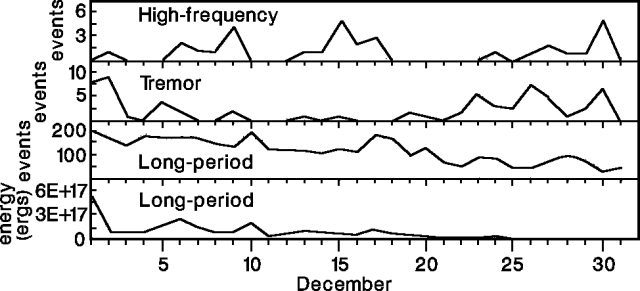Report on Galeras (Colombia) — December 1991
Bulletin of the Global Volcanism Network, vol. 16, no. 12 (December 1991)
Managing Editor: Lindsay McClelland.
Galeras (Colombia) Vigorous SO2 emission; fumaroles to 400°C; seismicity declines
Please cite this report as:
Global Volcanism Program, 1991. Report on Galeras (Colombia) (McClelland, L., ed.). Bulletin of the Global Volcanism Network, 16:12. Smithsonian Institution. https://doi.org/10.5479/si.GVP.BGVN199112-351080
Galeras
Colombia
1.22°N, 77.37°W; summit elev. 4276 m
All times are local (unless otherwise noted)
December seismicity had decreased notably from October and November. The number and energy of long-period events showed an overall decline through the end of the month (figure 50). High-frequency earthquakes and tremor episodes were small and infrequent.
Fumarole temperatures of 195-220°C at "Las Deformes", 405-411°C at the "Besolima" fissure (both down slightly from mid-1991), and 89°C at "la Calvache" (similar to previous values), were measured during visits to the summit cone on 11 and 12 December. The maximum SO2 flux detected during the month was 3,440 t/d (9 December; figure 51), higher than in recent months, but measurements on five other days in December did not yield rates exceeding 600 t/d.
 |
Figure 51. SO2 flux measured by COSPEC at Galeras, December 1991. The maximum value, on 9 December, was 3,440 t/d. Courtesy of INGEOMINAS. |
Geological Summary. Galeras, a stratovolcano with a large breached caldera located immediately west of the city of Pasto, is one of Colombia's most frequently active volcanoes. The dominantly andesitic complex has been active for more than 1 million years, and two major caldera collapse eruptions took place during the late Pleistocene. Long-term extensive hydrothermal alteration has contributed to large-scale edifice collapse on at least three occasions, producing debris avalanches that swept to the west and left a large open caldera inside which the modern cone has been constructed. Major explosive eruptions since the mid-Holocene have produced widespread tephra deposits and pyroclastic flows that swept all but the southern flanks. A central cone slightly lower than the caldera rim has been the site of numerous small-to-moderate eruptions since the time of the Spanish conquistadors.
Information Contacts: INGEOMINAS-OVP.


